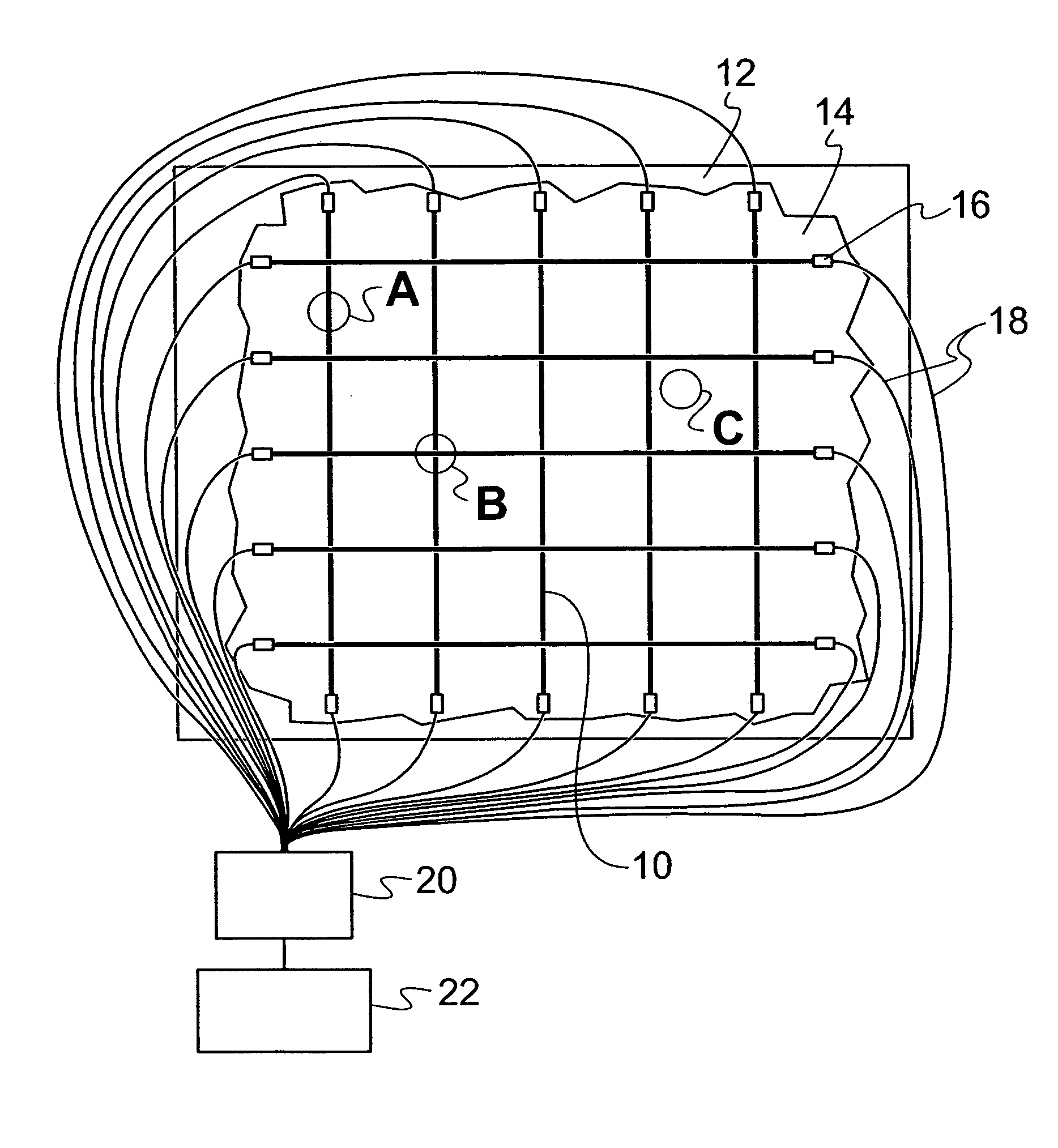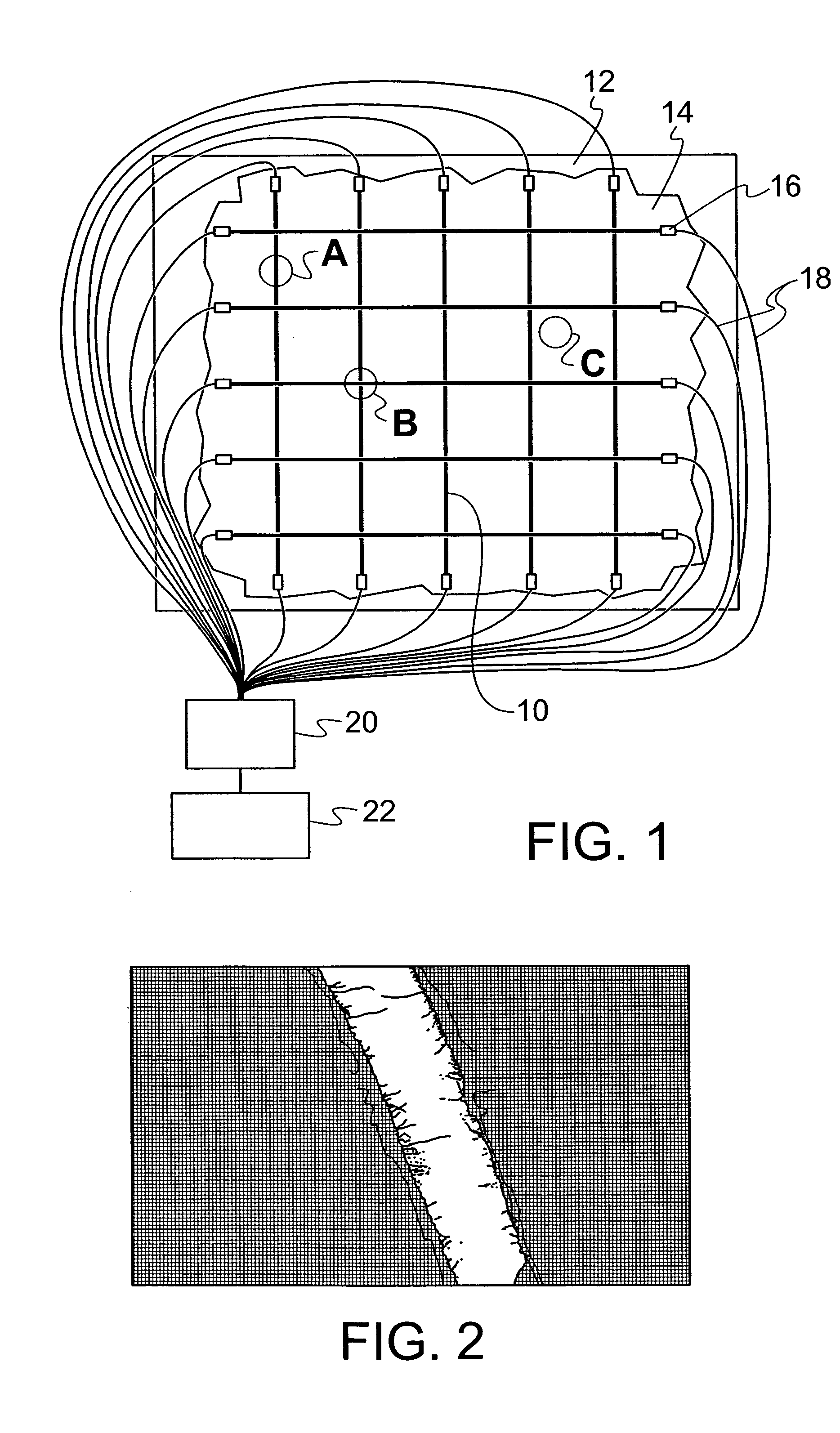Sensing system for monitoring the structural health of composite structures
a composite structure and sensor technology, applied in the field of sensor systems, can solve the problems of time-consuming and expensive monitoring of such structures, structural health of composite structures, and fractures and fatigue cracks of structural structures, and achieve the effects of high signal-to-noise ratio, easy adhesion, and controllable electrical and mechanical properties
- Summary
- Abstract
- Description
- Claims
- Application Information
AI Technical Summary
Benefits of technology
Problems solved by technology
Method used
Image
Examples
example 1
[0040] A 1″×6″ carbon fiber / epoxy composite laminate was subjected to a cyclical three point bend test in which the sample was loaded to 35 pounds then unloaded in a sinusoidal pattern. FIG. 3 illustrates the correlation between structural strain and changes in resistance. As can be seen, the sensor grid line resistance increases with applied load and returns to the initial resistance when the applied load is zero. With this small loading level, the resistance increases from an initial value of 4715 ohms to a value of 4723 ohms. Resistance levels rise to over 100 k-ohms when the sensor grid develops permanent cracks, so the sensing system is very sensitive over a wide range of strain values. It should be noted that after 100 cycles at approximately 2% strain, the sensor grid was still intact.
example 2
[0041] A 5″×5″ sensor grid was applied to a 12″×12″ carbon fiber / epoxy composite laminate. The grid lines had a spacing of two inches and were electrically isolated from each other. The laminate was supported with a ten inch diameter ring and a one inch diameter indentor was used to penetrate the laminate at the intersection of sensor lines X3 and Y3 as illustrated in FIG. 4. The circuits at X3 and Y3 were broken. Real-time data traces of indentor load and X-grid resistance values are shown in FIGS. 5A-5F. The load increases gradually as does the resistance value of X3. Resistance values of X2 and X4 also increase but at a reduced rate. Grid lines X1 and X5 which are supported almost entirely by the test ring show almost no change during the test. At 190 seconds there is an inflection in the load curve and X3 rapidly goes off scale. This is the time when the indentor tip pops through the plate. The loading continues and the indentor continues to punch through the plate as the load i...
example 3
[0042] A dynamic impact test was conducted on a 12″×12″ carbon fiber / epoxy / foam sandwich structure with a 5″×5″ sensor grid applied on its surface. A ⅞ inch diameter steel ball was shot with a velocity of 1000 feet / second at the sandwich panel which was supported by a circular ring. The ball was aimed at the intersection of sensor lines X3 and Y3 as depicted in FIG. 6. Resistance readings for all ten sensor lines were recorded at a frequency of 1 Mhz. The damage zone was limited to a diameter of approximately two inches. The carbon tow which makes up the braided structure of the sandwich skin still filled most of the damage zone, acting as tiny conductive brushes. It was noted that the sensor grid lines were still intact outside the damaged zone, which is an improvement over prior methods in which strain gages or other sensors fail when shock waves cause the sensor to pop off.
[0043]FIG. 7 shows the resistance reading of Y3 (impact site) and Y4 (nearest to impact). The resistance va...
PUM
| Property | Measurement | Unit |
|---|---|---|
| resistance | aaaaa | aaaaa |
| resistance | aaaaa | aaaaa |
| diameter | aaaaa | aaaaa |
Abstract
Description
Claims
Application Information
 Login to View More
Login to View More - R&D
- Intellectual Property
- Life Sciences
- Materials
- Tech Scout
- Unparalleled Data Quality
- Higher Quality Content
- 60% Fewer Hallucinations
Browse by: Latest US Patents, China's latest patents, Technical Efficacy Thesaurus, Application Domain, Technology Topic, Popular Technical Reports.
© 2025 PatSnap. All rights reserved.Legal|Privacy policy|Modern Slavery Act Transparency Statement|Sitemap|About US| Contact US: help@patsnap.com



